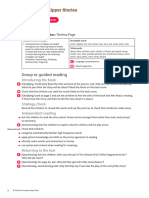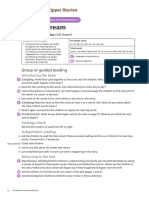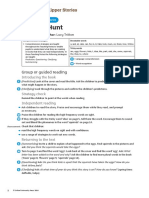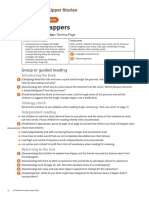The Dragon Dance
The Dragon Dance
Uploaded by
Dobre EsteraCopyright:
Available Formats
The Dragon Dance
The Dragon Dance
Uploaded by
Dobre EsteraCopyright
Available Formats
Share this document
Did you find this document useful?
Is this content inappropriate?
Copyright:
Available Formats
The Dragon Dance
The Dragon Dance
Uploaded by
Dobre EsteraCopyright:
Available Formats
Oxford Level 4 More Stories B
The Dragon Dance
Teaching Notes Author: Gill Howell
Comprehension strategies Decodable words
• Comprehension strategies are taught an, be, big, body, came, children, dance, did, do, dragon, good, got,
throughout the Teaching Notes to enable had, help(ed), her, inside, liked, long, made, them, town, upset,
pupils to understand what they are reading want(ed), were
in books that they can read independently.
In these Teaching Notes the following Tricky words
strategies are taught: don’t, everyone, fair, head, half, idea, painted, paper, people, school,
Prediction, Questioning, Clarifying tore, what, wonderful, wrong
= Language comprehension
= Word recognition
Group or guided reading
Introducing the book
(Questioning, Clarifying) Look at the cover illustration. Ask the children: What do you think the
children are doing?
Read the title. Encourage the children to segment the word ‘dragon’ into phonemes (‘d–r–a–g–o–n’).
(Clarifying) Talk about what the children already know about Chinese New Year traditions.
(Prediction) Ask them to say what they think might happen in the story.
• Look briefly through the story to confirm the children’s ideas.
• Use some of the high frequency words as you discuss the story.
Strategy check
Remind the children to sound the letters to help them work out new words.
Independent reading
• Ask children to read the story aloud. Praise and encourage them while they read, and prompt
as necessary.
(Questioning, Clarifying, Prediction) On page 5, ask: How do you think they will do the dragon dance?
On page 7, identify the long ‘ay’ vowel sound in ‘paper’.
(Questioning, Clarifying) On some of the pages, ask the children to say what is happening and why in
their own words.
Check that children:
• track text matching letters to sounds
• use phonic knowledge to sound out and blend the phonemes in words, particularly the decodable words.
Returning to the text
(Questioning, Clarifying) Check the children’s understanding and clarify any misunderstanding by
asking a variety of questions that require recall, inference and deduction such as: Why did Mrs May
tell the children to be careful? (page 7) Why did the dragon tear in half? (page 13) Why did Mrs May
say ‘It was only made of paper.’? How did the mums and dads help?
1 © Oxford University Press 2014
On page 20, ask the children to find ‘wonderful’ in the text and break it up into syllables. On page 21,
ask them to find ‘pleased’ in the text and sound out the phonemes (‘p–l–ea–s–ed’).
Turn to pages 12–13 and ask the children to find the two words with silent letters (‘wrong’ and ‘half’).
(Summarising) Ask children to retell the story in two or three sentences.
Group and independent reading activities
Read and spell phonically decodable two-syllable and three-syllable words.
Find ‘dragon’ in the text and count the syllables together.
• Ask the children to draw two columns on paper, and to look through the text and write down other
two-syllable words in one column, and words with more than two syllables in the other column.
Do they find these three-syllable words, ‘Anneena’, ‘everyone’, ‘wonderful’?
Use knowledge of common inflections in spelling, such as plurals.
Ask the children to find the plural words on page 10 (‘mums’ and ‘dads’).
• Talk about how an ‘s’ has been added to show there is more than one mum and more than one dad.
• Write a list of words from the story on the board: ‘dragon’, ‘head’, ‘body’ and ‘dance’.
• Discuss how to change the words into plural words.
• Talk about how ‘child’ and ‘person’ become plural. Ask the children to find the words in the story
(‘children’ page 1, ‘people’ page 24).
Do the children know that ‘Anneena’s’ does not mean lots of Anneenas?
Identify the main events and characters in stories.
You will need to place strips of paper or large Post-it notes over the text in one of the children’s books.
(Summarising) As a small group, pass the book around the children asking them in turn, page by
page, to tell you what happens in the story by referring to the illustrations.
• On each page tell the children to take off the paper strips and compare what was different about
their retelling and the written words.
Do the children describe the characters and events? Can they identify any differences in their retelling?
Speaking, listening and drama activities
Ask and answer questions, make relevant contributions, offer suggestions and take turns.
You will need some books on the Chinese New Year.
• In a circle, discuss and talk about what happens and why at Chinese New Year. Refer to books and
photographs.
• Ask: Why did the children want to do the dragon dance?
• Ask each child to contribute something they know about different celebrations.
Writing activities
Create short simple texts on paper that combine words with images.
• Discuss with the children how the words ‘dragon dance’ begin with the same sound.
• Brainstorm a list of other nouns beginning with ‘d’, especially animal
names, e.g. ‘dolphin’, ‘duck’, ‘dinosaur’, ‘donkey’, etc.
• Ask the children to plan and write a description of a dance on an
animal theme using alliteration for the title. Ask them to describe
For teachers
when and why their dance happens. Helping you with free eBooks, inspirational
resources, advice and support
• Encourage them to draw a picture of their costume to accompany For parents
their description. Helping your child’s learning
with free eBooks, essential
Do the children plan their writing? tips and fun activities
www.oxfordowl.co.uk
2 © Oxford University Press 2014
You might also like
- Fantastic FreddyDocument10 pagesFantastic FreddyDobre EsteraNo ratings yet
- Revised MH CET Law 5 Year Final Merit List For MS CandidatesDocument206 pagesRevised MH CET Law 5 Year Final Merit List For MS CandidatesPrashant DoundNo ratings yet
- Oxford Reading Tree Lesson Plan, Lesson 15 The Gulls' PicnicDocument4 pagesOxford Reading Tree Lesson Plan, Lesson 15 The Gulls' PicnicSix minutes0% (1)
- Ort BCK Stream TnsDocument2 pagesOrt BCK Stream TnsAlmira AslamNo ratings yet
- Ort BCK Dinosaurs TnsDocument3 pagesOrt BCK Dinosaurs TnsAroobaNo ratings yet
- The Box of Treasure: Group or Guided ReadingDocument3 pagesThe Box of Treasure: Group or Guided ReadingEryNo ratings yet
- Miau222223Document3 pagesMiau222223Tiberiu PopaNo ratings yet
- ort_bck_play_tnsDocument2 pagesort_bck_play_tnsahmadsubhanidogerNo ratings yet
- ort_bck_storm_tnsDocument2 pagesort_bck_storm_tnsahmadsubhanidogerNo ratings yet
- Ort BCK Laughprincess TnsDocument3 pagesOrt BCK Laughprincess TnsunwantedadvertisementNo ratings yet
- Fun at The BeachDocument2 pagesFun at The BeachThuy NguyenNo ratings yet
- Kipper's LacesDocument2 pagesKipper's LacesThuy NguyenNo ratings yet
- Decode Teaching Notes st5Document12 pagesDecode Teaching Notes st5Jiang TaoNo ratings yet
- Ort BCK Icecream TnsDocument2 pagesOrt BCK Icecream TnsarjunhdgjNo ratings yet
- Ort BCK Redplanet TnsDocument3 pagesOrt BCK Redplanet Tnshashimsaud880No ratings yet
- Spots!Document2 pagesSpots!Thuy NguyenNo ratings yet
- Ort Ttales Beautybeast TnsDocument4 pagesOrt Ttales Beautybeast Tnsyifan hanNo ratings yet
- Ort BCK Lostkey TnsDocument3 pagesOrt BCK Lostkey Tnsja7025No ratings yet
- Ort BCK Hideseek TnsDocument3 pagesOrt BCK Hideseek TnsMai HamoudaNo ratings yet
- Ort BCK Submarine TnsDocument3 pagesOrt BCK Submarine TnsMuhammad Mudassar JavedNo ratings yet
- Ort BCK Gran TnsDocument2 pagesOrt BCK Gran TnsRice BuoiNo ratings yet
- Ort BCK Brokenroof Tns PDFDocument3 pagesOrt BCK Brokenroof Tns PDFSobia KeswaniNo ratings yet
- Ort FP Fic Zip TnsDocument5 pagesOrt FP Fic Zip TnsMaha GaberNo ratings yet
- The Flying Carpet: Group or Guided ReadingDocument3 pagesThe Flying Carpet: Group or Guided ReadingMisbahSakraniNo ratings yet
- Ort BCK Castle TnsDocument2 pagesOrt BCK Castle Tnsgavin.macmillanNo ratings yet
- Tree Town Teachers NotesDocument5 pagesTree Town Teachers NotesLinda WangNo ratings yet
- Ort BCK Rainbowmach TnsDocument3 pagesOrt BCK Rainbowmach Tnsanil kumarNo ratings yet
- Ort DD Bigbadsnake TnsDocument5 pagesOrt DD Bigbadsnake TnsSmith ChelseaNo ratings yet
- The Egg Hunt: Group or Guided ReadingDocument3 pagesThe Egg Hunt: Group or Guided ReadingIrsa Shaheen100% (1)
- ort_bck_kidnappers_tnsDocument3 pagesort_bck_kidnappers_tnsiaz96145No ratings yet
- A New Dog ORTDocument2 pagesA New Dog ORTeyfs.2023No ratings yet
- ORT Nobody Wanted To PlayDocument3 pagesORT Nobody Wanted To PlayBatool FatimaNo ratings yet
- Ort BCK Goawayfloppy TnsDocument3 pagesOrt BCK Goawayfloppy Tnskda.maryam.javaidNo ratings yet
- Ort BCK Atschool TnsDocument2 pagesOrt BCK Atschool TnsSophia AdamNo ratings yet
- Tools and Animals Teachers NotesDocument5 pagesTools and Animals Teachers NotesLinda WangNo ratings yet
- How Can I Help You Teachers NotesDocument5 pagesHow Can I Help You Teachers NotesLinda WangNo ratings yet
- The BarbecueDocument2 pagesThe BarbecueThuy NguyenNo ratings yet
- The Lost TeddyDocument2 pagesThe Lost TeddyThuy NguyenNo ratings yet
- Ort BCK Redsblues TnsDocument2 pagesOrt BCK Redsblues TnsSophia AdamNo ratings yet
- Ort Ttales Childrenlir TnsDocument4 pagesOrt Ttales Childrenlir Tnsyifan hanNo ratings yet
- Ort BCK Newtrainers TnsDocument2 pagesOrt BCK Newtrainers Tnseyfs.2023No ratings yet
- Introducing and Using The Dialogic Reading Method: Pearson Family Book NightsDocument3 pagesIntroducing and Using The Dialogic Reading Method: Pearson Family Book NightsMyraChNo ratings yet
- Ort Bck Daylondon TnsDocument3 pagesOrt Bck Daylondon Tnsafshanaamir103No ratings yet
- Toads in The RoadDocument5 pagesToads in The RoadThuy NguyenNo ratings yet
- Tutoring Strategies For Preschool and KindergartenDocument11 pagesTutoring Strategies For Preschool and KindergartenKarrie Mae GolilaoNo ratings yet
- Ort BCK Prsntsdad TnsDocument2 pagesOrt BCK Prsntsdad Tnsdamaris.dobreNo ratings yet
- ORT Teacher NoteDocument2 pagesORT Teacher NoteSophia AdamNo ratings yet
- L11 - Baby Farm AnimalsDocument6 pagesL11 - Baby Farm AnimalsRAAM MECHNo ratings yet
- Ttops Graphns Goldscarab TnsDocument5 pagesTtops Graphns Goldscarab TnsStanzin NamgailNo ratings yet
- Ort Ttales Yoshistone TnsDocument4 pagesOrt Ttales Yoshistone TnsSana SaddozaiNo ratings yet
- Ort Ttales Eastsun TnsDocument4 pagesOrt Ttales Eastsun Tnsyifan hanNo ratings yet
- The LibraryDocument2 pagesThe LibraryThuy NguyenNo ratings yet
- Activity Cards PDFDocument39 pagesActivity Cards PDFatarah100% (2)
- Ort BCK Paris TnsDocument3 pagesOrt BCK Paris TnsAparna SHARMANo ratings yet
- Kujawski Anna 11Document10 pagesKujawski Anna 11api-302257313No ratings yet
- TN 15 Little Ducks WalkDocument2 pagesTN 15 Little Ducks Walkmarz sidNo ratings yet
- How We See Teachers NotesDocument5 pagesHow We See Teachers NotesLinda WangNo ratings yet
- Ort Ttales Dancprincess TnsDocument4 pagesOrt Ttales Dancprincess Tnsyifan hanNo ratings yet
- ort_bck_newhouse_tnsDocument2 pagesort_bck_newhouse_tnsahmadsubhanidogerNo ratings yet
- ShoppingDocument3 pagesShoppingThuy NguyenNo ratings yet
- SPELD SA Set 10.1 Book3 Walk and TalkDocument16 pagesSPELD SA Set 10.1 Book3 Walk and TalkLinh HaNo ratings yet
- Au M 1640566754 Fun Music Games For Kids Powerpoint Ver 1Document15 pagesAu M 1640566754 Fun Music Games For Kids Powerpoint Ver 1Dobre EsteraNo ratings yet
- KS1 All About Pulse and Rhythm MusicDocument13 pagesKS1 All About Pulse and Rhythm MusicDobre EsteraNo ratings yet
- T T 6994 Musical Instrument Video Powerpoint Ver 19Document16 pagesT T 6994 Musical Instrument Video Powerpoint Ver 19Dobre EsteraNo ratings yet
- Ai Ee Igh ComprehensionDocument3 pagesAi Ee Igh ComprehensionDobre EsteraNo ratings yet
- T L 820 Pencil Control Activity Sheets English RomanianDocument9 pagesT L 820 Pencil Control Activity Sheets English RomanianDobre Estera100% (1)
- Roi L 53528 A Sense of Autumn Pencil Control Activity Sheets EnglishDocument1 pageRoi L 53528 A Sense of Autumn Pencil Control Activity Sheets EnglishDobre EsteraNo ratings yet
- FIRST مسرحDocument1 pageFIRST مسرحAbdelhamed MedhatNo ratings yet
- B1 - Activity 3 - Brainstorming PDFDocument8 pagesB1 - Activity 3 - Brainstorming PDFafsdasfdNo ratings yet
- RussiaDocument3 pagesRussiaLaura GuerreroNo ratings yet
- The Celestial Cow Goddess Mehet-WeretDocument12 pagesThe Celestial Cow Goddess Mehet-Weretmai refaatNo ratings yet
- Highlights of Rizal JourneyDocument9 pagesHighlights of Rizal JourneyShienaMaeC.TecsonNo ratings yet
- UCSPDocument5 pagesUCSPpatriciarainbowdashNo ratings yet
- Research Proposal - Semiotic Analysis On Star Wars Movie SeriesDocument7 pagesResearch Proposal - Semiotic Analysis On Star Wars Movie SeriesharishNo ratings yet
- Soc L1Document31 pagesSoc L1Melody Grace DacubaNo ratings yet
- 100 Words To Impress A Native Speaker of English! Part TwoDocument5 pages100 Words To Impress A Native Speaker of English! Part Twoleo valentineNo ratings yet
- Module 2 21ST LiteratureDocument6 pagesModule 2 21ST Literaturejean ApostolNo ratings yet
- NARRATIVE Buwan NG WikaDocument2 pagesNARRATIVE Buwan NG WikaJames Bryan OlaivarNo ratings yet
- (I4-5) Lesson 2 - Matching Headings (Reading) - Form Completion (Listening)Document3 pages(I4-5) Lesson 2 - Matching Headings (Reading) - Form Completion (Listening)tlinhchi10No ratings yet
- Language 1Document59 pagesLanguage 1Abu EdwardNo ratings yet
- Stephanie Ganger, Disjunctive Circles Modern Intellectual Culture in Cuzco and The Journeys of Incan Antiquities, C. 1877-1921Document16 pagesStephanie Ganger, Disjunctive Circles Modern Intellectual Culture in Cuzco and The Journeys of Incan Antiquities, C. 1877-1921Alek BNo ratings yet
- DLR - English Language - GeneralDocument2 pagesDLR - English Language - Generalsebgem86No ratings yet
- Materi IntroductionDocument18 pagesMateri IntroductionPuspita Zulviandari100% (1)
- Minggu 1 12Document13 pagesMinggu 1 12Jong Yii PhinNo ratings yet
- Homework#2 WritingDocument2 pagesHomework#2 WritingMagaly RodriguezNo ratings yet
- American MythDocument18 pagesAmerican Mythkciah calisNo ratings yet
- தமிழ்Document13 pagesதமிழ்amarnath100% (6)
- The Thirty Tribes of The TurksDocument7 pagesThe Thirty Tribes of The TurksDanica HNo ratings yet
- Bien Dich Anh Viet - 2019Document58 pagesBien Dich Anh Viet - 2019Nguyen Thi Ly NaNo ratings yet
- RW 2 Describing Pictures and People TeacherDocument37 pagesRW 2 Describing Pictures and People TeacherOo LwinNo ratings yet
- The Art of Susanne WengerDocument4 pagesThe Art of Susanne WengerDiogo CãoNo ratings yet
- The Pintados Festival in TaclobanDocument2 pagesThe Pintados Festival in TaclobanErika Noreen Dela RosaNo ratings yet
- J ctvbj7g5b 26Document15 pagesJ ctvbj7g5b 26sejuliaNo ratings yet
- Answerkey Ef Upperi File TestDocument3 pagesAnswerkey Ef Upperi File TestIvan BenitezNo ratings yet
- Filipino 9 q4 RevisedDocument54 pagesFilipino 9 q4 RevisedMae Valerie MalanaNo ratings yet
- N A: A Benchmark For Measuring The Cultural Adaptability of Large Language ModelsDocument27 pagesN A: A Benchmark For Measuring The Cultural Adaptability of Large Language ModelsChanyeollie SehunnaNo ratings yet
































































































